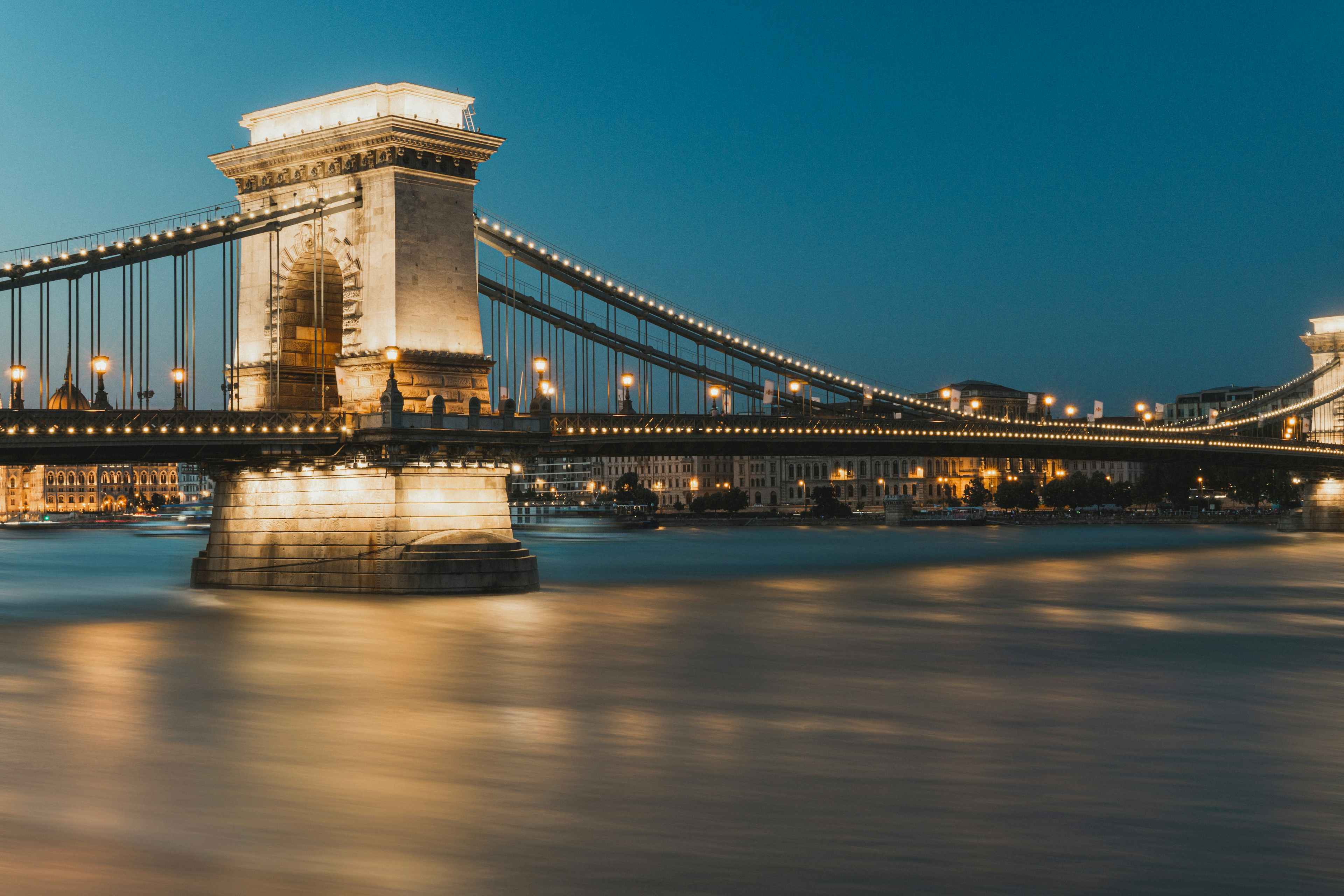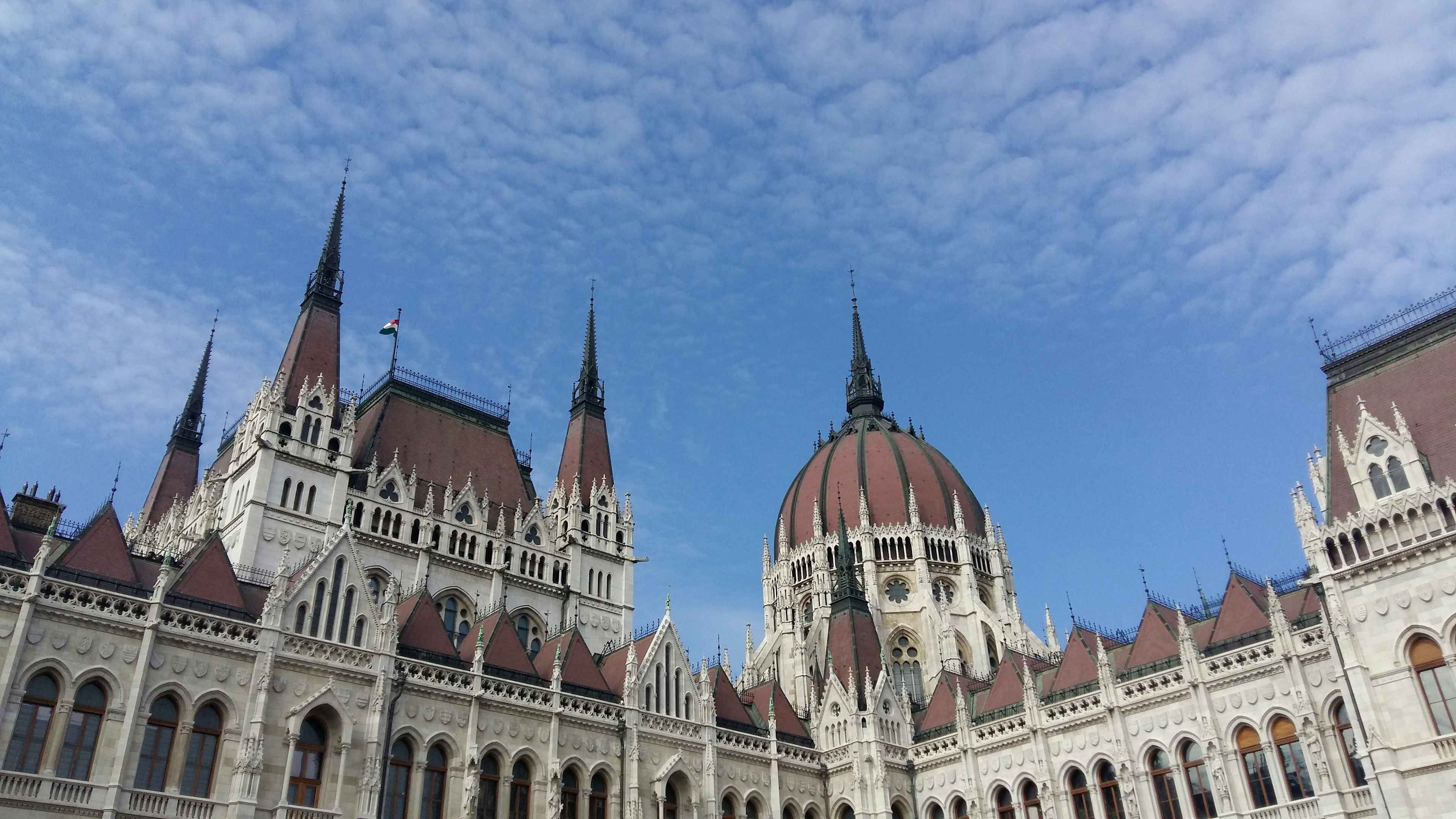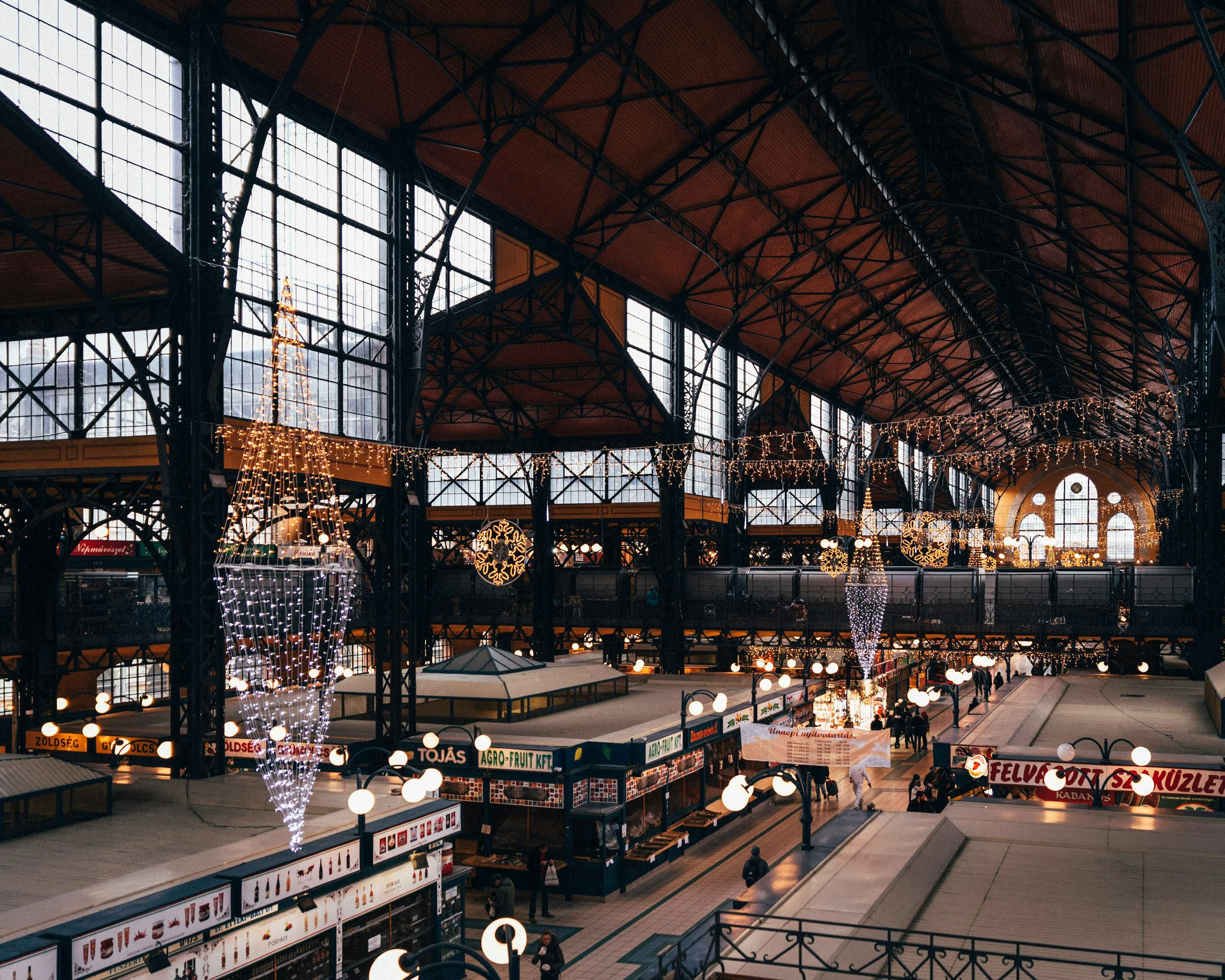Budapest Guide
Often described as the “Little Paris of Middle Europe”, Budapest is famous not only for the monuments reflecting its own 1,000-year-old culture, but also for the relics of others who settled here before that. The capital has two sides, Buda and Pest, stretching along the banks of the Danube, representing two different characters of the city.

Buda and its historic castle district offer medieval streets, houses, thermal baths, museums, even caves and Roman ruins. The dynamic Pest side boasts the largest parliament building in Europe, riverside promenades, flea markets, bookstores, café houses and the ruin-pubs. Budapest was recently listed within the top 6 cities in Europe, best suited for startups.

Opera—Heroes Square—Széchényi Bath
Andrássy Avenue is the new shopping street where you can find the Opera house, the old Ballet Institute and many theatres. Have a coffee or breakfast at Book Cafe (Lotz Hall), at one of Budapest's most beautiful cafe houses. Take the first underground line in Mainland Europe (line 1 or “yellow” line) and go to Hősök tere (Heroes’ Square). Here you can visit museums like Kunsthalle Budapest or Museum of Fine Arts, and the Vajdahunyad Castle. Row a boat on the City Park Boating Lake and enjoy the charming atmosphere. Finish your trip at Széchenyi thermal bath taking a hot tub and sauna.

Basilica—Chain Bridge—Buda Castle—Buda Old Town
Walk down to Basilica, and delight in the breathtaking view over Budapest from its panoramic terrace. Right next to it you can try some nice Hungarian wines at Divino. By crossing the Chain Bridge you may explore the Castle Hill on the Buda side (use one of the first funiculars in Europe to go up or to get down), then get back to Pest and see the Vörösmarty Square. Here you will also find Váci street, the old shopping street of Budapest.

Parlament—Great Market Hall—Gellért
Walk to the Parlament. (If you want to get inside the building, it is strongly recommended to register in advance). Take tram number 2 and get to the Great Market Hall. You will find lots of local food products there. Cross the Liberty Bridge and finish your day at Gellért thermal bath or Rudas.

Accomodation around the venue
Our venue is in the heart of the city, near Astoria, the Great Synagogue at Dohány street, and the party quarters in Budapest. The following districts around are a relatively short distance away:
- Erzsébetváros
- Palotanegyed
- Lipótváros
Airport Shuttle
The Liszt Ferenc International Airport is at the outskirts of Budapest. There is a public transport line 100E to connect the Liszt Ferenc Airport with the Deak Square in the centre of the city, from where you can reach any part of the city by public transport. 100E operates every day of the year, 24/7. The journey should take 30 to 40 minutes.
The “Airport shuttle bus single ticket” costs 2200 HUF (around 6 EUR), and is accepted only on this bus. You can buy it in ticket vending machines and in the BudapestGO app as well. Another option is the Budapest Pay&GO service that allows you to use your bankcard directly on the bus to buy and validate (a maximum of 5) tickets. If you need to pay in cash, you can buy your ticket at the BKK booths at the airport or directly from the bus driver.
Or you can take a taxi, at the dedicated taxi stations at 2A and 2B terminals, operated by Főtaxi. You have to tell the operators your destination, they will call you a car, and give a good estimate on the fare, which is usually around 28 EUR to the city centre. All Főtaxi cabs are equipped with a POS terminal, so you are able to pay either by card or in cash.

Transportation
The Budapest public transportation company (BKK) has several options for visitors who stay for a few days. One of the most popular ones is the Budapest Card for 72 hours, which costs 60 EUR, but has the benefit of offering several discounts on entry fees to baths, museums, and can be purchased online. A block of 10 single-ride tickets costs 11 EUR.
We recommend using the BudapestGO mobile app to use the public transportation in Budapest as a visitor. You can purchase tickets and use the map to plan your travel around the city. Get the app from the App Store or Google Play.
If you prefer to travel by car, some well-known taxi companies operating in Budapest are Főtaxi and Bolt.

Mobile data plan
In Hungary there are three main mobile network operators, T-Mobile (member of the Deutsche Telekom group), Yettel Hungary (member of the Norwegian Telenor group) and Vodafone.
T-Mobile has a prepaid option for mobile internet. Yettel also offers a prepaid mobile internet plan.
Useful Places around the venue
We've created a map, with useful places like shops, ATMs, pharmacies and places for lunch/breakfast and pubs.
Is Budapest an LGBTQ+ welcoming city?
You probably saw our message in the footer of this very website that JSConf Budapest welcomes everybody, and you’ve probably already read our Code of Conduct. Yet, you might still be hesitant. You might not know how safe you’ll be in our city, or what options you’ll have as a member of the LGBTQ+ community for activities outside the conference. How accepting is Budapest? What are the best, most inclusive bars out there? We hope we can help you out a little bit. We got in touch with Hungary’s largest and oldest LGBTQ+ organisation, Háttér Society, to compile the following list of information and tips for getting around in Budapest for members of the LGBTQ+ community.
First of all, we do take our Code of Conduct very seriously. We’ll do our best to make sure you’ll have the grandest old time during our conference. Outside of the conference, we can only give you some general advice, and, given our already challenging responsibilities during the event, we’re afraid we cannot provide any further assistance to ensure your safety and well-being in our city. With that out of the way, let’s see what Budapest has to offer.
The good news is, Budapest is an LGBTQ+ welcoming city. Homophobic and transphobic hate crime is punishable by Hungarian law, as is every kind of crime committed against a member of a community. Discrimination based on sexual orientation or gender identity is also strictly forbidden. If you ever encounter a rare case of discriminatory attitude or anything like this - for example, someone refuses to serve you at a bar or a restaurant - you are encouraged to get legal help. Feel free to contact Háttér Society at legalaid@hatter.hu.
The reality is, depending on the situation, you might get some looks or, worst-case scenario, get yelled at by someone. Our friends at Háttér Society told us that based on some real-world experience, depending on how visibly you present as a member of the LGBTQ+ community, these things can happen on some occasions. But it’s rare to have things escalate to the point of physical harm. We know that most of you will not speak or understand Hungarian, and not being able to defend yourselves is disheartening. But, in any case, however sad it makes us to write this, it’s easier to get out of the situation as fast as you can and not let things spoil your otherwise memorable time in Budapest.
What are my options for LGBTQ+ friendly activities in Budapest?
The LGBTQ website Pink Budapest has a great list summing up the nightlife in Budapest, claiming that this city has the best gay scene in Central Europe. It is also worth checking out TripAdvisor’s thematic offerings for events that happen during your stay.
Need anything?
Contact us, if you have any questions, or you feel we've missed something from this quick guide.
Recommendations near the venue
Places for tourists
Liberty bridge: a short stroll from Uránia Filmszínház will take you to the iconic Liberty Bridge, which offers stunning views of the Danube River and the Budapest skyline. The bridge is a popular spot for taking photos and enjoying a leisurely walk.
Dohány street Synagogue: the largest synagogue in Europe and a significant historical and cultural landmark in Budapest.
Great market hall: this bustling market is a great place to experience local Hungarian cuisine, shop for souvenirs, and soak up the vibrant atmosphere of Budapest.
Places to calm your nerves
The secret garden: tucked away in a hidden courtyard near Uránia Filmszínház. This is a quaint and charming spot that offers a peaceful escape from the bustling city. The garden features greenery, flowers, and cozy seating areas, making it a perfect place to relax and unwind.
Füvészkert: a must-visit botanical garden, offering a serene escape with its diverse collection of plants from around the world. It's the perfect place to immerse yourself in nature and explore rare species right in the heart of the city.
Places to visit when it comes to culture
Antique bookstore: small, independent bookstore that this hidden gem is a treasure trove of rare and vintage books. Book lovers will enjoy browsing through the shelves and discovering unique finds.
Resident Art Gallery: a small art gallery showcasing works by emerging local artists, this hidden gem is a great place to discover new talent and support the arts scene in Budapest. The gallery often hosts exhibitions and events, providing a unique cultural experience.
Hungarian national museum: if you're looking to delve into Hungary's rich history and culture, a visit to the Hungarian National Museum is an absolute must. This iconic institution offers a captivating journey through centuries of Hungarian heritage, featuring fascinating exhibitions and artifacts that will leave you inspired and enlightened.
Light Art Museum (LAM): offers a mesmerizing journey through interactive light installations and exhibits, making it a captivating destination for art enthusiasts and curious minds alike. Immerse yourself in a world of creativity and innovation at this unique museum in the heart of Budapest.
Places to party & drinks
Szimpla kert: step into the heart of Budapest's nightlife at Szimpla Kert, which is the original ruin pub. With its quirky decor, live music, and vibrant ambiance, it's a must-visit for an unforgettable evening out.
Vinikli Wine Bar: hidden in a historic building that intimate spot offers a selection of Hungarian wines and a warm, inviting atmosphere. It's a great place to unwind with a glass of wine and enjoy some quiet conversation.
Places to eat
Artizán bakery: hidden bakery tucked away on a side street that offers freshly baked bread, pastries, and sweet treats made with locally sourced ingredients. It's a great place to grab a snack or pick up some goodies to take home.
Mazel tov: savor the enchanting atmosphere and delicious Middle Eastern cuisine at Mazel Tov in Budapest. With its vibrant setting and flavorful dishes, it's a must-visit dining destination for locals and travelers alike.
Bors GasztroBár: for a taste of Budapest's vibrant street food scene, head to Bors GasztroBár. This cozy eatery offers a creative menu of gourmet sandwiches and soups bursting with flavor, making it a beloved spot for locals and tourists seeking delicious and affordable eats.
Karaván streetfood: - Lángos máshogy: a must-try for a delicious twist on the classic Hungarian treat, offering innovative toppings and flavors that will tantalize your taste buds. It's the perfect spot to indulge in a satisfying snack while exploring the vibrant food scene of Budapest.
Dobrumba: embark on a culinary adventure at Dobrumba, where Middle Eastern and Mediterranean flavors collide in a vibrant setting, offering a diverse menu that tantalizes the taste buds with every bite.
Két Szerecsen: discover the eclectic fusion of Hungarian and international cuisines at Két Szerecsen. With its cozy ambiance and innovative dishes, it's the perfect spot for a memorable dining experience in Budapest.
Mák Bisztró: a culinary gem where modern Hungarian cuisine meets elegant presentation. Indulge in seasonal delights crafted with locally-sourced ingredients, all served in a chic yet cozy atmosphere.
Kiosk Budapest: set against the backdrop of the iconic Vigadó Concert Hall, Kiosk Budapest offers a sophisticated dining experience with panoramic views of the Danube River. Indulge in modern Hungarian cuisine crafted with a creative flair, complemented by an extensive wine list and impeccable service.
Places to grab a specialty coffee
Espresso Embassy: offers a wide selection of specialty coffees and delicious pastries in a modern and stylish setting. They serve the coffee for you during JSConf Budapest 2024.
My Little Melbourne Coffee: a popular coffee shop known for its excellent specialty coffee and cozy atmosphere.
Fekete: a trendy coffee shop and brunch spot that serves top-quality coffee and a variety of light meals and snacks in a chic and minimalist space.
Madal Cafe: a cozy coffee shop with a relaxed vibe, offering a range of specialty coffee drinks and sweet treats. It's a great spot to unwind and enjoy a cup of coffee. Blue Bird Café: a charming coffee shop that serves freshly brewed coffee, homemade pastries, and light meals in a cozy and welcoming atmosphere.